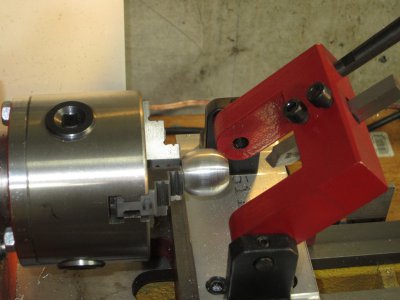I would like to put a sphere/radius on the end of a 1/2" diameter shaft using a 12" lathe. I know there are a few different ways to do this but I am specifically interested in a method I have heard about that involves turning the sphere using the swivel function of the compound rest. Has anybody ever heard of that? If so, can you point me to something that goes through the set up?
Thanks
Rick
This absolutely can be done, HOWEVER it is dependent on your lathe. You have to be able to solidly mount a cutting tool, so that it's cutting tip is pretty near the center line of the compound rest's travel axis. (That's not "required", but for a radius that small, it's gonna need to be pretty close. The radius gets big, fast as you move away from the center the pivot action.). Next, you have to be able to retract the compound so that the most extreme point of the cutting tip is BEHIND the pivot. In your case, half inch rod, and assuming the cutter is dead nutz lined up to the pivot, you'd need to be a quarter inch behind the pivot to get the quarter inch radius/half inch "dome" you're looking for. And you're going to need to adjust said compound rest's locking mechanism as tight as it can possibly be, while still being able to easily and SMOOTHLY rotate it. And last, you've got to driver the CROSS slide until the pivot for the compound is lined up dead center to the lathe spindle centerline.
as
@woodchucker said, It's dead easy on a South Bend 9 with a rocker post, except that it's easier to ditch the tool holder and shim the tool bit directly into place. On other lathes I'm sure it's possible, and some, it's quite probably not possible...
The key is, on any lathe, (and while the general concept is the same, EVERY lathe is going to be different), to put the tool bit in a position where swiveling the compound rest makes the tool follow an arc. The tool WILL follow a circular arc anywhere that you put it. Putting it closer to the work than where the pivot is will make a concave surface. Putting it behind the pivot will make a convex surface.
The absolute best advice I can give you is to set up a tool as best as you can by these directions (or any on the web), put a piece of similar stock in the chuck, move tool, cross slide, and compound into somewhere close, and just go through the motions. Don't even turn the lathe on. Pretty quick, you'll see where you need to be. That's kind of the best way anyhow... You can find "some" datums to help you dial in on where you want to be, but you WILL be using the eyeball method to know when it's just right. It does work, and "can" work well... But you can't really dial indicate this sort of shenanigans that you're arguably probably not supposed to be doing anyhow.
Oh yeah... If you're not able to point the tool "straight" to the point you want it to be, if it has to come in at some angle? You can always grind the point accordingly, so the cutting geometry is presented properly even if the tool points off at a strange angle from it.


